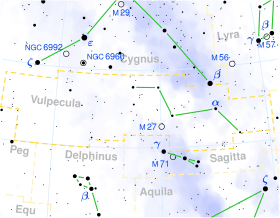1 Vulpeculae
| Observation data Epoch J2000 Equinox J2000 | |
|---|---|
| Constellation | Vulpecula |
| Right ascension | 19h 16m 13.03970s[1] |
| Declination | 21° 23′ 25.5339″[1] |
| Apparent magnitude (V) | 4.77[2] |
| Characteristics | |
| Spectral type | B4IV[3] |
| U−B color index | -0.54[2] |
| B−V color index | -0.05[2] |
| Astrometry | |
| Radial velocity (Rv) | -17.00[4] km/s |
| Proper motion (μ) | RA: +0.21[1] mas/yr Dec.: -6.84[1] mas/yr |
| Parallax (π) | 4.02 ± 0.37[1] mas |
| Distance | 810 ± 70 ly (250 ± 20 pc) |
| Absolute magnitude (MV) | -2.20[3] |
| Details | |
| Mass | 6.9[5] M☉ |
| Luminosity | 919[3] L☉ |
| Surface gravity (log g) | 3.74[6] cgs |
| Temperature | 16,787[6] K |
| Metallicity [Fe/H] | 0.00[6] dex |
| Rotational velocity (v sin i) | 80[7] km/s |
| Other designations | |
| Database references | |
| SIMBAD | data |
1 Vulpeculae is a class B4IV[3] (blue subgiant) star in the constellation Vulpecula. Its apparent magnitude is 4.77[2] and it is approximately 810 light years away based on parallax.[1]
The primary, A, is a spectroscopic binary with a period around 250 days; in addition, it has companions B, with magnitude 11.6 and separation 39.1", and C, with magnitude 12.8 and separation 43.6".[8][9]
Component A is also a suspected variable star, reported to vary from 4.57 to 4.77 in magnitude.[10] It was reported as possibly variable in 1952 during a search for β CMa variables,[11] but has not been seen to vary since. It was listed as one of the least variable stars based on Hipparcos photometry.[12]
References
- 1 2 3 4 5 6 Van Leeuwen, F. (2007). "Validation of the new Hipparcos reduction". Astronomy and Astrophysics. 474 (2): 653. arXiv:0708.1752
 . Bibcode:2007A&A...474..653V. doi:10.1051/0004-6361:20078357. Vizier catalog entry
. Bibcode:2007A&A...474..653V. doi:10.1051/0004-6361:20078357. Vizier catalog entry - 1 2 3 4 Ducati, J. R. (2002). "VizieR Online Data Catalog: Catalogue of Stellar Photometry in Johnson's 11-color system". CDS/ADC Collection of Electronic Catalogues. 2237. Bibcode:2002yCat.2237....0D.
- 1 2 3 4 Anderson, E.; Francis, Ch. (2012). "XHIP: An extended hipparcos compilation". Astronomy Letters. 38 (5): 331. arXiv:1108.4971
 . Bibcode:2012AstL...38..331A. doi:10.1134/S1063773712050015. Vizier catalog entry
. Bibcode:2012AstL...38..331A. doi:10.1134/S1063773712050015. Vizier catalog entry - ↑ Wilson, R. E. (1953). General Catalogue of Stellar Radial Velocities. Carnegie Institution of Washington. Bibcode:1953GCRV..C......0W. LCCN 54001336.
- ↑ Tetzlaff, N.; Neuhäuser, R.; Hohle, M. M. (2011). "A catalogue of young runaway Hipparcos stars within 3 kpc from the Sun". Monthly Notices of the Royal Astronomical Society. 410: 190. arXiv:1007.4883
 . Bibcode:2011MNRAS.410..190T. doi:10.1111/j.1365-2966.2010.17434.x. Vizier catalog entry
. Bibcode:2011MNRAS.410..190T. doi:10.1111/j.1365-2966.2010.17434.x. Vizier catalog entry - 1 2 3 Wu, Yue; Singh, H. P.; Prugniel, P.; Gupta, R.; Koleva, M. (2010). "Coudé-feed stellar spectral library – atmospheric parameters". Astronomy & Astrophysics. 525: A71. arXiv:1009.1491
 . Bibcode:2011A&A...525A..71W. doi:10.1051/0004-6361/201015014.
. Bibcode:2011A&A...525A..71W. doi:10.1051/0004-6361/201015014. - ↑ Abt, Helmut A.; Levato, Hugo; Grosso, Monica (2002). "Rotational Velocities of B Stars". The Astrophysical Journal. 573: 359. Bibcode:2002ApJ...573..359A. doi:10.1086/340590.
- ↑ Dommanget, J.; Nys, O. (2002). "VizieR Online Data Catalog: CCDM (Catalog of Components of Double & Multiple stars) (Dommanget+ 2002)". VizieR On-line Data Catalog: I/274. Originally published in: Observations et Travaux 54. 1274. Bibcode:2002yCat.1274....0D. Vizier catalog entry
- ↑ Mason, Brian D.; Wycoff, Gary L.; Hartkopf, William I.; Douglass, Geoffrey G.; Worley, Charles E. (2001). "The 2001 US Naval Observatory Double Star CD-ROM. I. The Washington Double Star Catalog". The Astronomical Journal. 122 (6): 3466. Bibcode:2001AJ....122.3466M. doi:10.1086/323920. Vizier catalog entry
- ↑ Samus, N. N.; Durlevich, O. V.; et al. (2009). "VizieR Online Data Catalog: General Catalogue of Variable Stars (Samus+ 2007-2013)". VizieR On-line Data Catalog: B/gcvs. Originally published in: 2009yCat....102025S. 1. Bibcode:2009yCat....1.2025S.
- ↑ Walker, M. F. (1952). "A search for stars of the beta Canis Majoris type". Astronomical Journal. 57: 227. Bibcode:1952AJ.....57..227W. doi:10.1086/106759.
- ↑ Adelman, S. J. (2001). "Research Note Hipparcos photometry: The least variable stars". Astronomy and Astrophysics. 367: 297. Bibcode:2001A&A...367..297A. doi:10.1051/0004-6361:20000567.
This article is issued from Wikipedia - version of the 10/29/2016. The text is available under the Creative Commons Attribution/Share Alike but additional terms may apply for the media files.
